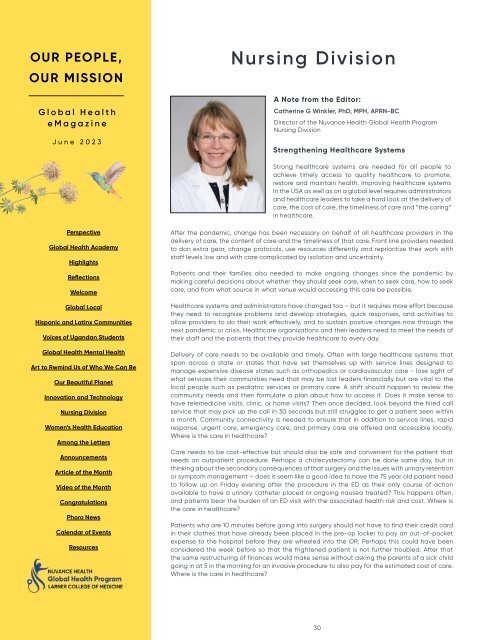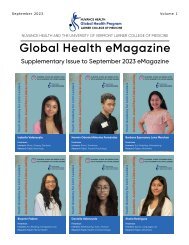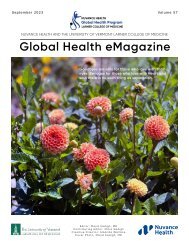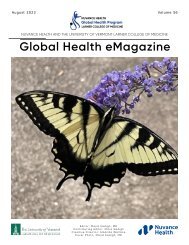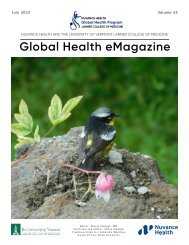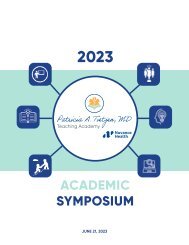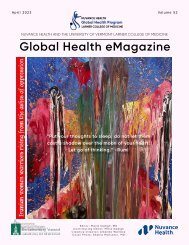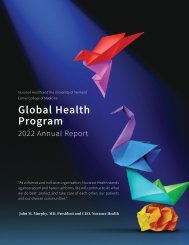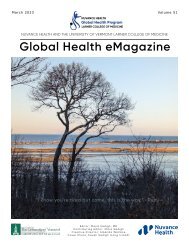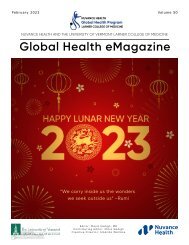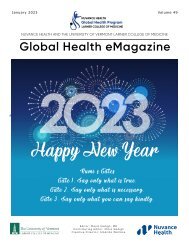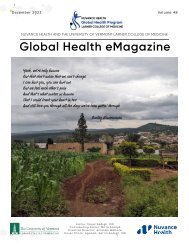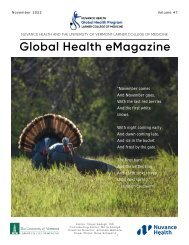eMagazine June 2023
You also want an ePaper? Increase the reach of your titles
YUMPU automatically turns print PDFs into web optimized ePapers that Google loves.
OUR PEOPLE,<br />
OUR MISSION<br />
Global Health<br />
<strong>eMagazine</strong><br />
<strong>June</strong> <strong>2023</strong><br />
Nursing Division<br />
A Note from the Editor:<br />
Catherine G Winkler, PhD, MPH, APRN-BC<br />
Director of the Nuvance Health Global Health Program<br />
Nursing Division<br />
Strengthening Healthcare Systems<br />
Strong healthcare systems are needed for all people to<br />
achieve timely access to quality healthcare to promote,<br />
restore and maintain health. Improving healthcare systems<br />
In the USA as well as on a global level requires administrators<br />
and healthcare leaders to take a hard look at the delivery of<br />
care, the cost of care, the timeliness of care and “the caring”<br />
in healthcare.<br />
Perspective<br />
Global Health Academy<br />
Highlights<br />
Reflections<br />
Welcome<br />
Global Local<br />
Hispanic and Latinx Communities<br />
Voices of Ugandan Students<br />
Global Health Mental Health<br />
Art to Rwmind Us of Who We Can Be<br />
Our Beautiful Planet<br />
Innovation and Technology<br />
Nursing Division<br />
Women’s Health Education<br />
Among the Letters<br />
Announcements<br />
Article of the Month<br />
Video of the Month<br />
Congratulations<br />
Phoro News<br />
Calendar of Events<br />
Resources<br />
After the pandemic, change has been necessary on behalf of all healthcare providers in the<br />
delivery of care, the content of care and the timeliness of that care. Front line providers needed<br />
to don extra gear, change protocols, use resources differently and reprioritize their work with<br />
staff levels low and with care complicated by isolation and uncertainty.<br />
Patients and their families also needed to make ongoing changes since the pandemic by<br />
making careful decisions about whether they should seek care, when to seek care, how to seek<br />
care, and from what source in what venue would accessing this care be possible.<br />
Healthcare systems and administrators have changed too – but it requires more effort because<br />
they need to recognize problems and develop strategies, quick responses, and activities to<br />
allow providers to do their work effectively, and to sustain positive changes now through the<br />
next pandemic or crisis. Healthcare organizations and their leaders need to meet the needs of<br />
their staff and the patients that they provide healthcare to every day.<br />
Delivery of care needs to be available and timely. Often with large healthcare systems that<br />
span across a state or states that have set themselves up with service lines designed to<br />
manage expensive disease states such as orthopedics or cardiovascular care - lose sight of<br />
what services their communities need that may be lost leaders financially but are vital to the<br />
local people such as pediatric services or primary care. A shift should happen to review the<br />
community needs and then formulate a plan about how to access it. Does it make sense to<br />
have telemedicine visits, clinic, or home visits? Then once decided, look beyond the hired call<br />
service that may pick up the call in 30 seconds but still struggles to get a patient seen within<br />
a month. Community connectivity is needed to ensure that in addition to service lines, rapid<br />
response, urgent care, emergency care, and primary care are offered and accessible locally.<br />
Where is the care in healthcare?<br />
Care needs to be cost-effective but should also be safe and convenient for the patient that<br />
needs an outpatient procedure. Perhaps a cholecystectomy can be done same day, but in<br />
thinking about the secondary consequences of that surgery and the issues with urinary retention<br />
or symptom management – does it seem like a good idea to have the 75 year old patient need<br />
to follow up on Friday evening after the procedure in the ED as their only course of action<br />
available to have a urinary catheter placed or ongoing nausea treated? This happens often,<br />
and patients bear the burden of an ED visit with the associated health risk and cost. Where is<br />
the care in healthcare?<br />
Patients who are 10 minutes before going into surgery should not have to find their credit card<br />
in their clothes that have already been placed in the pre-op locker to pay an out-of-pocket<br />
expense to the hospital before they are wheeled into the OR. Perhaps this could have been<br />
considered the week before so that the frightened patient is not further troubled. After that<br />
the same restructuring of finances would make sense without asking the parents of a sick child<br />
going in at 5 in the morning for an invasive procedure to also pay for the estimated cost of care.<br />
Where is the care in healthcare?<br />
30


